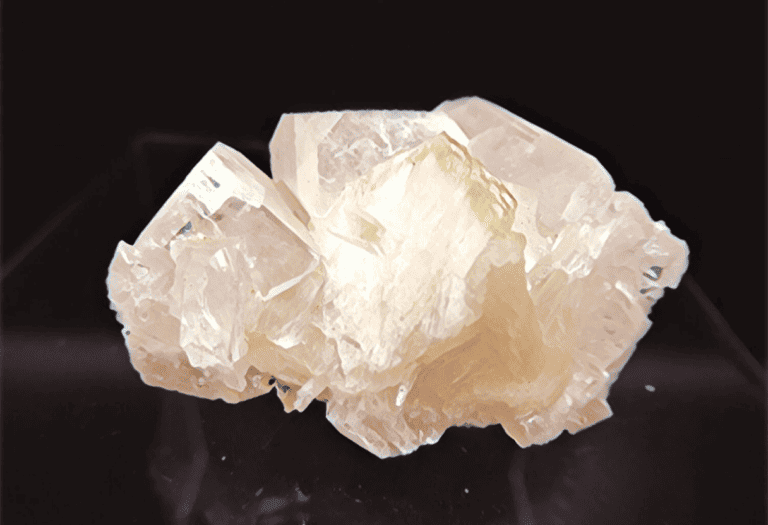Discovering chambersite, a rare manganese borate mineral, can be a thrilling experience for mineral collectors and geology enthusiasts alike.
You’re about to learn how to identify this unique mineral by its distinguishing characteristics.
Deep purple, tetrahedral gleam, that’s chambersite’s hidden dream. White streak it leaves behind, laughs at magnets, not so kind. Hard as glass, light splits in two, near salt it waits for you.
How to Identify chambersite Through Testing
When you’re on the hunt for chambersite, armed with a bit of know-how and a few tools, you can confidently test for this rare mineral.
Visual Inspection
Start by examining your specimen with a keen eye. Look for the classic dark purple to deep blue color that’s a telltale sign you might have chambersite. Its distinctive crystals, often taking on a tetrahedral shape, are a dead giveaway.
The Streak Test
Take a piece of unglazed porcelain tile and rub the mineral across it. Chambersite should leave a white streak, even though its color might suggest otherwise. This is an easy and non-destructive way to test your sample.
Magnet Test
Though chambersite isn’t magnetic, checking for a reaction with a magnet can help rule out other minerals. Place a magnet near your specimen. If there is no attraction, you can move forward with confidence, focusing on more specific chambersite tests.
Hardness Test
You’ll need a Mohs scale hardness kit for this test. Chambersite scores between 7-7.5, meaning it can scratch glass but not as readily as diamond. Gently try to scratch your mineral and see if it fits this hardness profile.
Birefringence Test
Place your sample under a petrographic microscope and look for evidence of double refraction, a phenomenon caused by light splitting as it enters anisotropic materials like chambersite. You’re looking for the typical ‘double vision’ appearance within the crystal.
Checking The Diaphaneity
Hold your potential chambersite up to the light. If it’s genuine, it should display translucency, allowing light to pass through but not transparent enough to see clearly through the crystal.
Single or Double Refraction
Chambersite is uniaxial, meaning it shows double refraction. Under polarized light, rotate your sample; it should exhibit changes in intensity, confirming its double refractive nature.
Refractive Index Test
By using a refractometer, you can measure the mineral’s refractive index. For chambersite, you’re aiming for an RI in the range of 1.712 – 1.722. Ensure your stone is clean and properly calibrated for accurate results.
Finding The Specific Gravity
The specific gravity of chambersite is relatively high, ranging from 3.4 to 3.7. You’ll need a hydrostatic balance or a specific gravity kit to determine if your sample falls within this density range.
Identifying Chambersites in the Field
Field identification involves assessing the environment. Chambersite typically forms in evaporite deposits. Search around salt domes or dried lakes where boron concentrations might be higher.
Recognizing Potential Chambersite Rocks
If you’ve come across rock formations near saline environments or geological settings prone to boron accumulation, you might have stumbled upon chambersite host rocks. Examine such rocks closely for the signs you’ve learned about – color, crystal form, and other distinguishing properties.
Remember, proper testing of chambersite involves careful observations and specific evaluations. Each assessment gets you closer to verifying the true nature of your sample. With patience and precision, you’re well-equipped to pinpoint this unique mineral.
Physical Characteristics of chambersites

Chambersite stands out in the mineral world due to its unique physical properties. It’s readily identifiable through its distinctive crystal habit—typically, you’ll find it as pseudo-octahedral crystals that can either be small and drusy or larger and more defined. These formations are a telltale sign you’re looking at chambersite.
When examining potential chambersite specimens, color and luster are your clues. This mineral usually displays a deep purple to violet color, absorbing you into its richness. Sometimes, you might come across hues ranging from dark reddish-brown to nearly black which can test your identification skills. The crystals themselves have a greasy to vitreous luster, giving them a shiny appearance that’s quite eye-catching in the right light.
Transparency also plays a key role in identification. Chambersite crystals are traditionally translucent to opaque. This can vary depending on the quality and size of the crystals you’re examining. Larger crystals tend to show a greater degree of translucency, which is another characteristic detail to note during your analysis.
Do not forget to consider the cleavage and fracture of the mineral. While chambersite does not have any apparent cleavage, it does possess an uneven to sub-conchoidal fracture which is crucial during physical examination. Checking for this can help confirm if the mineral in your grasp is indeed chambersite or some other lookalike.
How Are chambersite Formed?
Chambersite crystals are born in unique geological conditions. Typically found in evaporite deposits, chambersite originates when minerals precipitate from brine solutions. These briny waters are a result of seas or lakes undergoing extreme evaporation.
Key factors, like temperature and pressure, influence the formation process. As the water evaporates, it becomes supersaturated, causing ions to precipitate out and form minerals. In the case of chambersite, manganese, boron, oxygen, and hydrogen ions come together.
Specific environmental conditions are essential for chambersite to form its characteristic crystal structure. For example, relatively high boron concentrations in the brine seem to be critical. Over time, under the right conditions, these ions slowly bond, creating the crystal lattice that typifies chambersite.
Keep in mind, these mineral-rich brines can occur in various settings, including salt lakes, playas, and deep-sea hydrothermal vents. While chambersite is often associated with the evaporitic rocks of sedimentary origin, it may also occur as a secondary mineral in some types of igneous rocks. Its presence hints at the complex interplay of geochemical processes shaping our planet’s crust.
Understanding these formation processes may enhance your field identification skills and refine your ability to distinguish chambersite from similar minerals. Remember, recognising the geologic clues that hint at chambersite formations can be as important as identifying the mineral itself.
Preparation for chambersite Hunting
When setting out to find this elusive mineral, you’ll need to prepare adequately to maximize your chances of success. Proper preparation ensures effective hunting and also guarantees your safety during the search.
Gathering the Right Tools
Before you venture into the field, it’s critical to have the right tools for identification and collection. Here are the essentials you’ll need:
- Geologist’s hammer: For extracting samples from host rocks.
- Hand lens: This magnifying tool allows you to take a closer look at the mineral’s features.
- Streak plate: Vital for performing a streak test—a key identifier for chambersite.
- Magnet: Helpful in distinguishing chambersite through its magnetic properties.
- Notebook: To record observations and locations of potential finds.
- GPS device: For navigating terrain and marking specific sites.
- Safety goggles: Protects your eyes from flying debris.
These items will facilitate a thorough and accurate identification process once you have collected your samples.
Safety Considerations
Your safety should be a top priority during chambersite hunting. Here are critical safety tips:
- Wear appropriate gear: Durable gloves, sturdy boots, and a hard hat can safeguard you from sharp rocks and potential falls.
- Stay aware of your surroundings: Pay attention to the terrain and any wildlife or environmental hazards.
- Bring a first aid kit: Always have basic medical supplies on hand for minor injuries.
- Stay hydrated: Carry enough water, especially if you’re searching in arid regions.
- Inform someone of your plans: Let a friend or family member know where you’re going and when you plan to return.
By keeping these points in mind, you’ll be set for a productive and secure chambersite hunting experience.
Handling and Care of Found chambersites

Once you’ve identified a genuine piece of chambersite, it’s crucial to know how to safely handle and preserve your find. With proper care, you can maintain the aesthetic and scientific value of the mineral. Here’s a detailed look at how to clean and store your chambersite specimens.
Cleaning Chambersites
To begin cleaning chambersite:
- Use distilled water to avoid any chemical interaction with tap water.
- Avoid harsh chemicals that might damage the mineral’s surface.
- Gently brush with a soft-bristled brush to remove loose dirt and debris.
- Pat dry with a nonabrasive, soft cloth to minimize water spots or streaking.
Be mindful that chambersite is relatively soft (hardness of 2.5 to 3 on the Mohs scale). Excessive force or the use of metal tools during cleaning could scratch or break the specimen.
Storing Chambersite
Proper storage is just as important as careful cleaning. For storing chambersite:
- Utilize padded containers to protect against physical damage.
- Avoid storing in high humidity environments to prevent potential water damage.
- Keep chambersite away from direct sunlight, which may cause fading or other alterations.
- Label your specimens with the location and date of collection.
If storing multiple samples together, consider segregating your chambersite to prevent them from scratching each other or being scratched by harder minerals. Soft, acid-free tissue paper or individual polyurethane bags can be perfect for this purpose.
Monitoring the storage conditions periodically ensures that your chambersite remains in pristine condition for years to come. Make adjustments as needed based on changes in temperature, humidity, or other environmental factors.
Remember, the aesthetic qualities of chambersite are best preserved when your handling and care are meticulous. Your efforts in following these steps will reflect in the longevity and quality of your mineral collection.
Conclusion: Confirming Chambersite Real
You’ve now got the tools and knowledge to confirm if you’ve stumbled upon the rare and intriguing chambersite.
Remember, the key to accurate identification lies in diligent testing and keen observation. Don’t forget to use the tests discussed, from visual inspections to specific gravity tests, to validate your find. With the right approach and a bit of patience, you’ll be able to differentiate chambersite from look-alikes and appreciate its unique qualities. Keep your safety gear on hand, handle your specimens with care, and store them properly to preserve their natural beauty and value.
Happy hunting, and may your efforts lead you to genuine chambersite treasures.



![Setting Prices for Handmade Jewelry [year]](https://observationhobbies.com/wp-content/uploads/2024/01/dVTRvDJ0W4koSsyHjCF9V-768x439.jpg)
![Arizona Rockhounding Sites in [year]: Best Spots & Treasures](https://observationhobbies.com/wp-content/uploads/2024/01/a6mX8Cj68tW4b49jOXReb-768x439.jpg)


